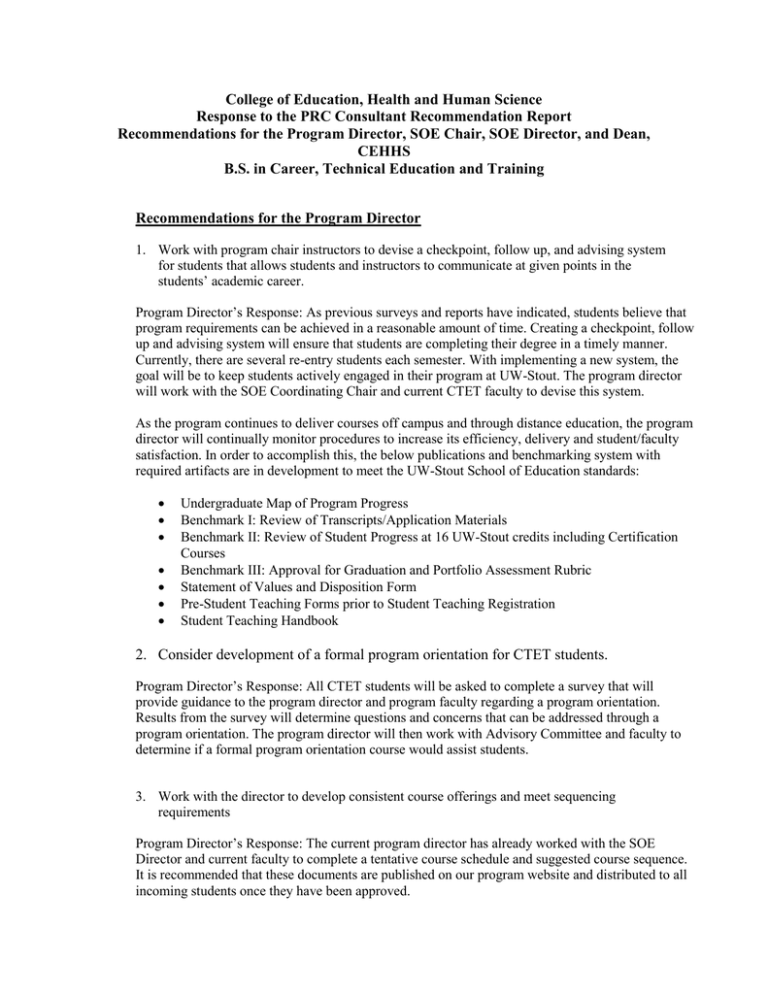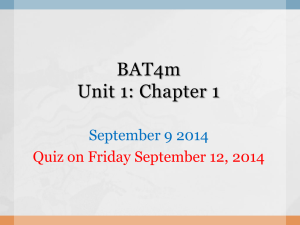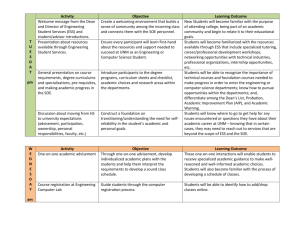College of Education, Health and Human Science
advertisement

College of Education, Health and Human Science Response to the PRC Consultant Recommendation Report Recommendations for the Program Director, SOE Chair, SOE Director, and Dean, CEHHS B.S. in Career, Technical Education and Training Recommendations for the Program Director 1. Work with program chair instructors to devise a checkpoint, follow up, and advising system for students that allows students and instructors to communicate at given points in the students’ academic career. Program Director’s Response: As previous surveys and reports have indicated, students believe that program requirements can be achieved in a reasonable amount of time. Creating a checkpoint, follow up and advising system will ensure that students are completing their degree in a timely manner. Currently, there are several re-entry students each semester. With implementing a new system, the goal will be to keep students actively engaged in their program at UW-Stout. The program director will work with the SOE Coordinating Chair and current CTET faculty to devise this system. As the program continues to deliver courses off campus and through distance education, the program director will continually monitor procedures to increase its efficiency, delivery and student/faculty satisfaction. In order to accomplish this, the below publications and benchmarking system with required artifacts are in development to meet the UW-Stout School of Education standards: Undergraduate Map of Program Progress Benchmark I: Review of Transcripts/Application Materials Benchmark II: Review of Student Progress at 16 UW-Stout credits including Certification Courses Benchmark III: Approval for Graduation and Portfolio Assessment Rubric Statement of Values and Disposition Form Pre-Student Teaching Forms prior to Student Teaching Registration Student Teaching Handbook 2. Consider development of a formal program orientation for CTET students. Program Director’s Response: All CTET students will be asked to complete a survey that will provide guidance to the program director and program faculty regarding a program orientation. Results from the survey will determine questions and concerns that can be addressed through a program orientation. The program director will then work with Advisory Committee and faculty to determine if a formal program orientation course would assist students. 3. Work with the director to develop consistent course offerings and meet sequencing requirements Program Director’s Response: The current program director has already worked with the SOE Director and current faculty to complete a tentative course schedule and suggested course sequence. It is recommended that these documents are published on our program website and distributed to all incoming students once they have been approved. Recommendations for the Director, School of Education 1. Discuss student concerns regarding feedback, consistency, and clarity of expectations in online instruction with instructors, perhaps considering some standardization as appropriate. Response by the SOE Director: The SOE Director and the SOE Coordinating Chair will conference with the BS in CTET faculty regarding student concerns about instructor feedback, consistency and clarity of expectations. Recommended guidelines will be developed and course evaluations will be evaluated to determine whether further intervention is needed. 2. Consider working with the Dean and LTS to equip a classroom with the ECHO system to bring the classroom experience to DE students, as well as investigate and/or support instruction in courses using software, such as Jing, Skype, and pod-casts, in order to perhaps help improve clarity of major topics, online assignments, due dates, etc. Response by the SOE Director: The SOE Director will consult with the CEHHS Dean and the BS in CTET faculty to determine the need for further technology upgrades to targeted classrooms. Further, the SOE Director will work with the Program Director and faculty to determine the need for additional software/hardware to support instruction and to assist faculty in clarifying online assignments and due dates. 3. Work with the Program Director to develop consistent course offerings and meet sequencing requirements Response by the SOE Director: The SOE Director has supported efforts to develop consistent course offerings with a recommended and explicit course sequence. Further, over the past year, the SOE Director has collaborated with the B.S. in CTET Program Director and the SOE Coordinating Chair to develop strategies for communicating course offerings and a recommended course sequence to current and potential students. Recommendations for the Dean of the College of Education, Health, and Human Services 1. Work with the school to provide stable leadership for the CTET program, and with adequate release to be able to work with the diverse CTET population. Response: The interim Program Director was appointed when the former Program Director was unable to continue in that position. The Interim PD has done a tremendous job getting the program back on track. The Dean will work with the SOE Director to have a plan in place by this summer to appoint a more permanent Program Director. 2. Assess needs for faculty to reduce the significant use of overloads and adjuncts in order to more effectively serve students. Response: Most of the CTE coursework at both the undergraduate and graduate level is customized instruction. At this point we are not able to hire faculty to teach CI coursework, necessitating the hiring of academic staff, most of whom are part-time at this time. The Dean will work with the SOE Director and Instructional Chair to determine whether there is sufficient need to hire an instructor on a more full-time basis for the CI CTE coursework offered in remote sites. The SOE Director and Instructional Chair are reducing the amount of overload instruction throughout SOE. 3. Assess clerical and/or paraprofessional support needs for the CTET program as identified in the student and instructor surveys. The Dean will work with the SOE Director and Instructional Chair to assess the clerical and paraprofessional support and the capacity of the CTE CI budget to support LTE support if needed.





